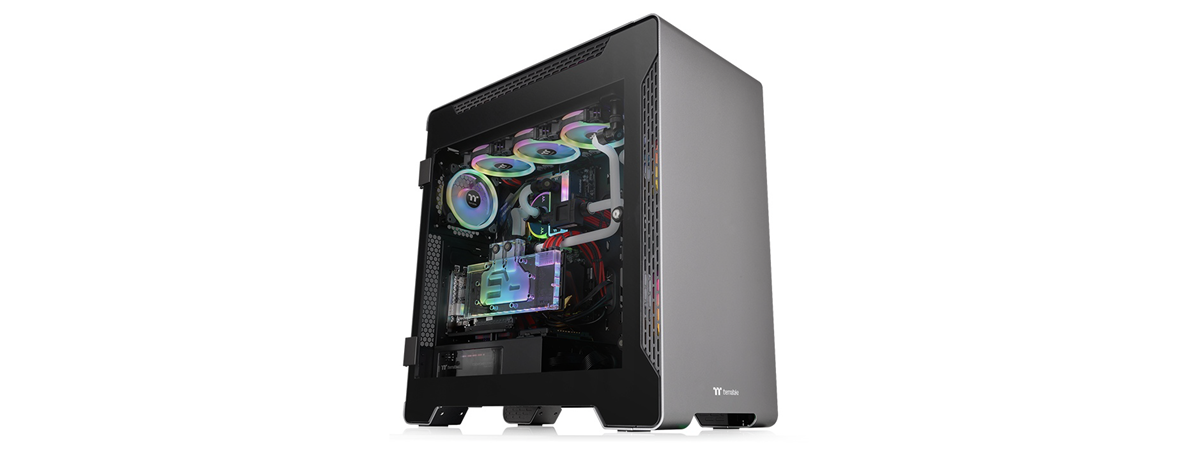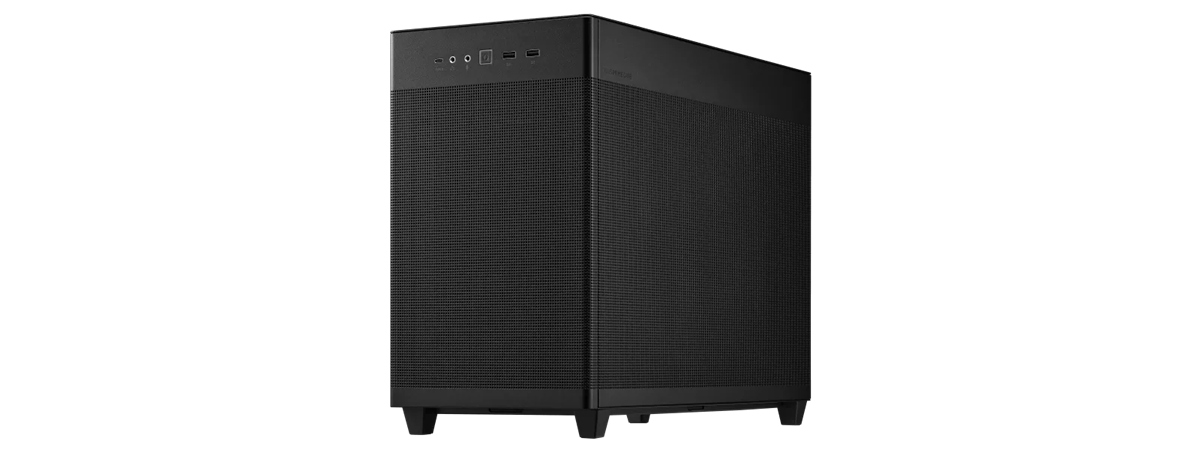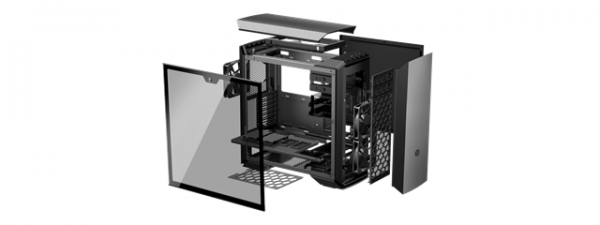
When you’re assembling a high-performance PC, the case you choose is important. It doesn’t just alter the way your computer looks, but also how well it works and stays cool. The NZXT H7 Flow is one of the best cases from NZXT, and the latest 2024 model promises great airflow, a well-thought-out design, and easy-to-use features. I spent some time building a system with this case and testing it out, and I’d like to share with you what I found. If you’re thinking about the NZXT H7 Flow for your next build, keep reading to see if it’s the right choice for you:
NOTE: This review is about the 2024 model of the NZXT H7 Flow computer case, not about the previous H7 Flow from 2022, still available in stores.
NZXT H7 Flow 2024: Who is it good for?
The NZXT H7 Flow is an ideal choice for:
- PC enthusiasts and gamers who need excellent airflow and cooling performance
- Users who plan to build high-end systems with powerful components
- Those who like a minimalist yet stylish design
- Anyone who appreciates the tidiness that results from great cable management
Pros and cons
In my opinion, these are the best things about the NZXT H7 Flow:
- Exceptional airflow design that helps keep hardware cool even under heavy use
- Minimalist looks, with clean lines and a tempered glass side panel
- Plenty of room for large GPUs, multiple storage devices, and extensive cooling solutions
- User-friendly building experience and well-thought-out cable management channels
As for downsides:
- Only has two USB-A and one USB-C port on its front, which might be too few for some users
- Compared to some competitors offering similar features, the NZXT H7 Flow is a bit more expensive

Verdict
The NZXT H7 Flow 2024 impressed me with its good looks and useful features. One of the things I loved most was how well it keeps all my high-end components cool thanks to its top-notch airflow. If you care about keeping your system running smoothly, this case is a great choice. Of course, there are a couple of minor things I noticed which aren’t ideal. The front ports are a bit limited, and its cost is a bit on the upper side. However, if you want a case that not only looks great but also lets you build your computer easily and does a superb job at cooling, the NZXT H7 Flow is definitely worth checking out.
Unboxing the NZXT H7 Flow 2024
The NZXT H7 Flow arrives in a sturdy cardboard box designed to protect it well against the inevitable hardships of the shipping process. The box features some large black and white sketches of the case, as well as a smaller color picture. While the design is simple, it’s effective; it managed to get me excited to open it up and start building the PC sooner rather than later.

The packaging of the NZXT H7 Flow
Unpacking the NZXT H7 Flow is pretty simple, though you may want to ask a friend or someone in your family for an extra set of hands. That’s because the box is quite large and heavy. The case is well-protected inside, with thick foam on the top and bottom, and the glass panel is wrapped in plastic to keep it scratch-free. Along with the case, you find a user manual, and there are some accessories included too - they’re tucked neatly inside the case itself.

Unboxing the NZXT H7 Flow
To get to the accessories, you need to remove the metallic side panel. Once it’s off, you can spot a cardboard box securely strapped inside.

A box with accessories is found inside the case
Inside the box, you find all the accessories needed to set up your hardware. It includes screws, standoffs, and zip ties to help you get everything mounted.

The case bundles screws, standoffs, and zip ties
When you open the box, the quality and attention to detail stand out. The NZXT H7 Flow computer case feels sturdy, and its elegant design catches your eye immediately.
Design and hardware specifications
The NZXT H7 Flow is made from high-quality steel, and it features perforated mesh panels on the front and top to increase airflow. The left side is made of tempered glass, perfect for showing off your build, while the right side panel is about three quarters solid steel and one quarter mesh. This design maximizes airflow for better cooling but also helps filter out dust, keeping your system clean and efficient. Oh, and there’s one more good part: cleaning is a breeze because all the panels can be easily removed, and they require no tools for that.

The panels of the case are removable
The size of the NZXT H7 Flow is just right for a mid-tower case, giving you plenty of room without feeling too bulky. In case you’d like to know its exact dimensions, the case is 544 mm tall (21.4 inches, including the feet), 244 mm wide (9.6 inches), and 468 mm deep (18.4 inches), and it weighs about 11.13 kg, which is roughly 24.5 pounds. It supports a variety of motherboard sizes, including ATX, Mini-ITX, Micro-ATX, and even E-ATX (up to 277 mm or 10.9 inches), giving you lots of options to create all kinds of builds.

The case can fit all kinds of mainboards
In terms of component clearance, the H7 Flow accommodates large graphics cards up to 410 mm in length and CPU coolers up to 185 mm in height. The power supply shroud supports ATX PSUs up to 200 mm in length, which simply put, means compatibility with most power supply units on the market. Moreover, storage options are generous, with mounting locations for up to four 2.5-inch drives and two 3.5-inch drives.

There are quite a few locations for SSDs and HDDs
As I briefly mentioned earlier, the NZXT H7 Flow is fantastic when it comes to cooling. You can fit up to three 120 mm or two 140 mm fans on both the front and top panels, plus a single 120 mm or 140 mm fan in the back. You can also put up to three 120 mm fans at the bottom, though it doesn’t support 140 mm fans there. Worth noting, the case comes with three 120 mm fans already installed in the front. They run at 1,350 ± 150 RPM (Rotations Per Minute) and a noise level of 24.1 dBA, so they’re relatively quiet.

The case has three pre-mounted fans
If you’re into liquid cooling, you may want to know that the case can also fit large radiators - up to 420 mm in the front, 360 mm on the top, and up to 140 mm in the rear. This means it’s a great pick if you want to use bulky AIO coolers or even custom water-cooling loops.

You can fit large radiators and a lot of fans in this PC case
The front I/O panel is right at the top of the case, making it easy to reach. It comes with two USB 3.2 Gen 1 Type-A ports, one USB 3.2 Gen 2x2 Type-C port (which supports extremely fast 20 Gbps speeds), and a 3.5 mm audio jack. This port selection covers the basics, and it’s nice to have that high-speed USB-C port on the front. However, some people might say that there aren’t quite enough ports, especially if you need to work with a lot of USB devices at the same time.

The front (top) panel features a 20 Gbps USB-C port
If you’d like to read more about the features and specifications of the NZXT H7 Flow computer case, check out its official webpage: NZXT | H7 Flow | Mid-Tower ATX Airflow Case.
The NZXT H7 Flow not only looks great but also offers excellent specs. Its airflow seems well designed, the materials it’s made of are high quality, and the interior of the case is spacious.
Building a PC inside the NZXT H7 Flow 2024
When I unboxed the NZXT H7 Flow, I was eager to start building. Part of that because I love building computers, and part because this new PC was for our team. More specifically, for my colleague, Ciprian, who had picked out all the hardware himself. Oh, and although the case looked beautiful on the outside, I was actually more curious to see how everything would fit inside. Here’s how it all worked out:
First up was installing the motherboard, an ASUS ProArt X670E-CREATOR WIFI that I reviewed a while ago. Putting it into the case was very easy, as I didn’t have to adjust anything because all the standoffs were already in the right places. Plus, the large interior gave me plenty of room to work, so the whole process was smooth.

Mounting the mainboard inside the NZXT H7 Flow
With the motherboard in place, I moved on to the processor. After placing the AMD Ryzen 7 9700X into its socket, it was time for the cooler: Ciprian wanted to use a Noctua NH-D15 air cooler. Although the NZXT H7 Flow supports large radiators and AIO coolers, he prefers traditional air coolers. The good news is that the cooler fits inside the case without any issues, even if it’s quite tall, measuring no more no less than 165 mm in height!

The air cooler I used is large and quite tall
Next on the list were the RAM sticks - Kingston FURY Renegade DDR5-7200 32GB - which were a bit tricky to install because the cooler was above them. However, with a bit of care, I managed to pop them into place. A word of advice: Don’t do what I did; instead, mount the CPU cooler last so that it doesn’t get in the way when placing the other components…

The RAM sticks are underneath the cooler
Although I had to work under the large cooler again, mounting the M.2 NVMe SSD, a 2 TB CORSAIR MP700 PRO, was relatively easy. That’s thanks to the clever design of the motherboard, which comes with a quick-release system for the heatsink on top of the primary PCIe 5.0 SSD slot.

The PCIe Gen5 SSD sits under a dedicated heatsink
While it wasn’t the case for me, if you have storage drives using SATA, it's worth noting that you can easily mount them in the rear chamber of the case. Larger 3.5-inch hard drives can be fitted behind the motherboard, and smaller 2.5-inch solid-state drives have a separate cage at the bottom front.

The case has a SSD cage at the bottom front
For the graphics part, I mounted an ASUS Dual GeForce RTX 4060 OC Edition, a GPU that’s not huge but not tiny either. It’s about 123 mm (4.8 inches) wide and 227 mm (8.9 inches) long. It fit perfectly, which was no surprise considering that the H7 Flow can handle GPUs up to 410 mm long. If you intend to brag about your graphics card, it’s worth noting that the case also supports vertical mounting. However, you'll need to buy an additional Vertical GPU Mounting Kit for that.

An NVIDIA GeForce 4060 GPU mounted in the NZXT H7 Flow case
Installing the power supply was straightforward, as I used a fully modular Corsair RM850e that’s 140 mm (5.51 inches) long. The case can accommodate PSUs that are up to 200 mm (7.87 inches) long, so I had no problem with the Corsair power supply unit.
One thing I appreciated here, and which I’m pretty sure you’ll like too, is the fact that the separate rear chamber of the case keeps the PSU out of sight. And that means not only that things look clean, but also that cable routing is easier. Of course, the cutouts and generous space behind the motherboard tray also play a part in all that.

The power supply unit and its cables are hidden from view
Cable management is a task that often gives me headaches. 🙂 With the H7 Flow, it was actually quite easy, and not only for the power supply unit area that I mentioned just now. That’s because the case offers wide cable channels, lots of tie-down points, and pre-mounted Velcro straps. The latter are a very nice touch, helping you (and me 🙂) keep everything neat and tidy.

Cable management in the NZXT H7 Flow
Once everything was installed, I stepped back to admire my work. The mesh front and top panels give the case a modern look and also deliver on the airflow front, and the tempered glass side panel lets you show off all your components. What do you think?

The final result is a high-performance computer
All in all, building a PC in the NZXT H7 Flow 2024 is a satisfying experience. The case’s design makes everything, from installing the motherboard to managing cables, relatively easy. I like how the computer turned out, both in terms of looks and performance. The only thing that I would change would be to replace the fans on the processor cooler with black ones. You know, just to get that all-black image. 🙂 Otherwise, if you’re looking for a new computer case that looks beautiful, offers great airflow, and - quite importantly - helps you build your PC easily, my experience says that you should give the NZXT H7 Flow a try.
What’s your opinion about the NZXT H7 Flow 2024?
Now that I’ve shared my experience with the NZXT H7 Flow 2024 computer case, I’d really like to hear from you. Did you get it and did you use this case to build your PC? What aspects did you appreciate, and where do you think NZXT could improve it? Your opinions could help others make a better decision about whether the NZXT H7 Flow is the right choice for their next system.


 03.12.2024
03.12.2024 


